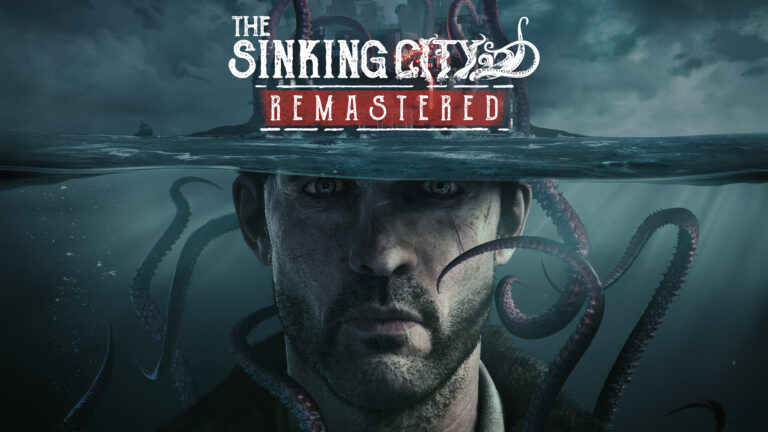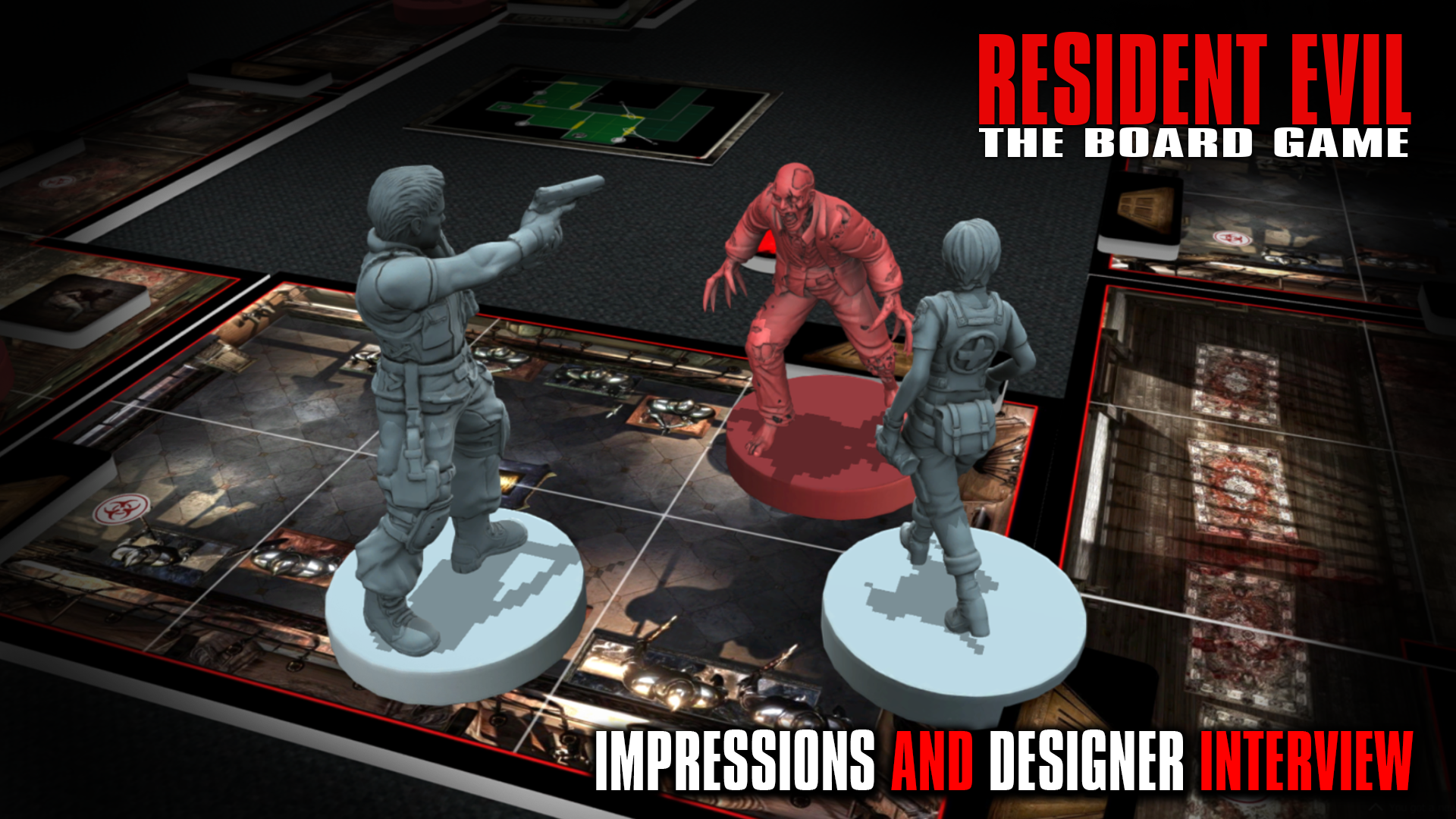
Over the last few years, some of our favorite games have seen a surprising rise in adaptions — not in the form of movies or books necessarily, but in the form of board games. Dark Souls, Devil May Cry, and yes, Resident Evil, have all made the leap from screen to table thanks to the efforts of Steamforged Games. Partnered with each game’s publisher and acquiring funding through Kickstarter backers, Steamforged has built up quite a library of unique titles. Resident Evil has become perhaps their largest franchise, or at least the most ubiquitous one, as they are set to begin production on a third, full-scale board game adapting an entry from the series.
Based on the 2002 remake of Resident Evil, this latest entry promises to be the most nerve-wracking yet, with four playable members of S.T.A.R.S. (Chris, Jill, Rebecca, and Barry) and a hoard of zombies and monsters waiting to bring them to an early grave. I had the chance to play a session of this game’s demo with Steamforged Lead Designer and Writer Sherwin Matthews and Junior Game Designer Psy White, where they answered questions as well as walked me through an exhilarating round of Resident Evil The Board Game.
To start with, I’ll do a quick rundown of my impressions, then I’ll follow it up with an exclusive interview with Matthews!
The Game
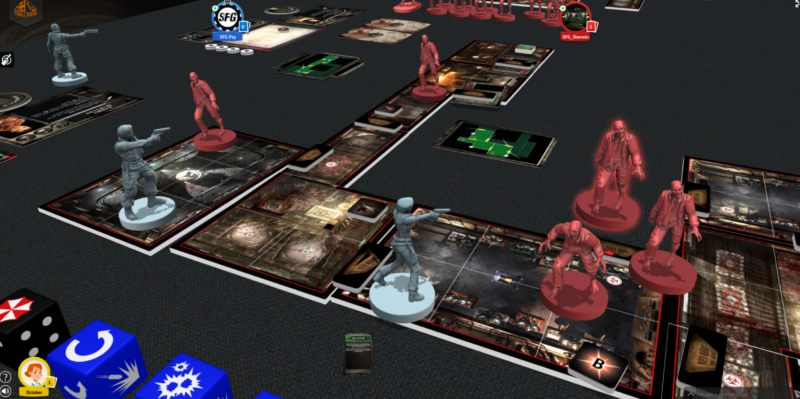
The demo can be played digitally here (the final release will be a full physical board game), where you can group up with three other players to try and survive online. Don’t worry, the game starts mostly set-up, with all the pieces, cards, and parts of the board already in place to begin a game. All you have to do is pick your character and drag them onto the board (Chris and Jill are on the board to start with, but I swapped out Jill for Rebecca). After a quick read-through of the rules (which are mostly the same as Resident Evil 3: The Board Game from earlier this year), we were set to get survivin’. Your basic goal is to escape the mansion, and if all goes well, together. You aren’t playing against your friends in this experience, but rather cooperating with them to try and make it out alive. Each of you has your own specialties, load-outs, and health meters, so you’ll have to take care of yourself — but it’s in your best interest to help your friends if they end up in a sticky situation rather than leaving them to die. You can also play the game completely single-player if surviving alone is more your cup of herbal tea.
The gameplay consists of three phases: Action Phase, Reaction Phase, and Tension Phase. Each of these phases is made up of decisions made by both the players and by the random nature of the dice and cards.
In the Action Phase, a player can take four separate actions — these can consist of simply walking four spaces, or opening a door (and closing it, counting as a separate action), picking up and/or using an item, attacking a nearby enemy, or a combination of each. Actions are how you keep the game’s momentum moving forward, and this is where you’ll do your exploring. Once a player’s Action Phase is over, the game will go into the Reaction Phase.
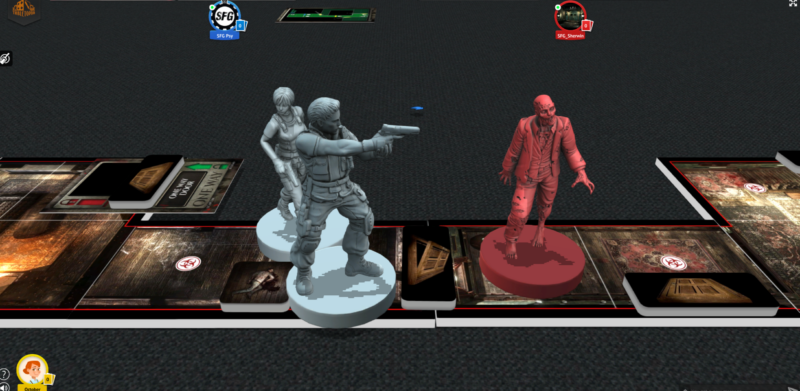
During this phase, it’s the dead’s time to make their move. This has a chance of pitting players into combat with nearby enemies or simply step forward a space as they zero in on you. This might not sound too daunting, but you’d be surprised at how quickly the dead can overwhelm you, as they did Psy and me early on in our playthrough. Thankfully, this only applies to enemies on that player’s tile (the map is broken up into multiple tiles that are pieced together), or a tile connected to theirs — such as an open door. A good way of keeping things under control is by using one of your Action Phase moves to shut a door behind you. Sure, it eats up a move, but keeping the dead at bay during the next phase might be more important.
If a zed (or other beastie) gets close enough to grapple with you, you’re left to literally roll your way out of harm with the set of dice provided. A good roll can see you “wiggle the left stick” out of potential damage, shoving the corpse back a space, but a bad roll could see you taking a hit to your health. It’s really impressive how such simple depictions (leaving 99% of the action in your imagination) faithfully recreate the video game’s pacing in these fights, the feeling of a zombie lurching at you out of the shadows and that little lunge they do (I bet you can hear that gasping sigh right now) as their hands grasp your shoulders, ready to take a bite. If anything, it’s better to try and avoid zombies entirely as often as possible, just like in the original classics.
Resident Evil is not about killing every single zombie you come across, it’s not a game where you throw dice at the problem until they go away, because you will very quickly run out of ammunition. It’s a game where we’re very much focused on resource management, it’s focused on thinking of intellegent ways to block things.
-Sherwin Matthews
Regardless of which way your battle goes, this is all followed up by the Tension Phase. During this point in the game, a card is drawn from the “Tension Deck”, which will give the players a prompt that could have dire ramifications on the game. Best chance? Nothing, the room remains still and empty, and you breathe a sigh of relief. But if you draw poorly, monsters could overwhelm you out of nowhere in an instant…or worse.
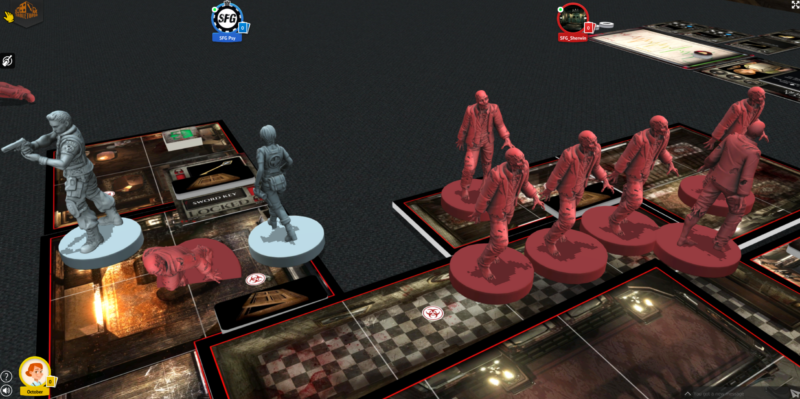
These three phases mutate the game into a million and one directions and the instant tension and anxiety of staying alive in the ever so dangerous halls of the mansion is palpable within minutes of starting up a game. I was holding a conversation and interview while playing and the survival horror of this experience still managed to leak through despite it. Pop on REmake‘s score while you’re at it, and in no time you’ll find yourself playing Resident Evil exactly as you remember it, despite the little plastic figures and cardboard coins.
I haven’t even mentioned some of the more specific survival horror elements, like the limited inventory, resource management, or item pick-ups. Hell, you even have to use kerosene and a lighter to burn bodies lest the horrifying V-ACT takes effect on stagnant corpses, turning them into incredibly dangerous Crimson Heads. You can even pick up “missions” that you can send non-player characters to accomplish, such as rescuing other survivors. There’s a depth to this experience that I admit I kinda wasn’t expecting (my board game experiences begin with Monopoly and end with Clue) and I relished every moment.
It’s very telling that during the hybrid gameplay session and interview that I conducted, we ended up getting lost in the game after a certain point and I forgot to keep asking questions. We played for a solid two hours and I later had to email the rest of my questions to Sherwin on account of having too much fun.
The Interview
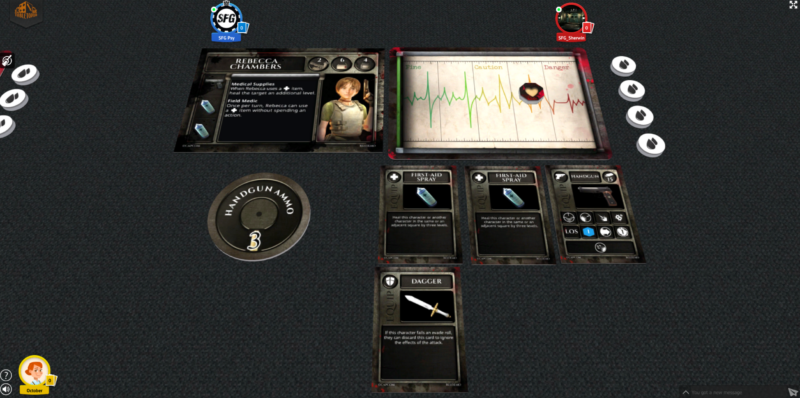
Rely: How did you go about translating the gameplay of Resident Evil into a board game, and more accurately, the spirit?
Sherwin: One of the things we always do when we’re designing a game is we sit down and we try to establish what the core DNA of that game is. What is it that makes Resident Evil the game that it is? If you’re sitting down to play this, how do you identify this game, how would you describe it? It’s suspenseful, it’s scary, it’s got lots of enemies in it, there’s loads of different bits and pieces that you’d pick up.
Once you can latch onto those, you can then start to think about layering in mechanics that really work to that. For example, “Oh, you attack zombies”, okay well we can make loads of mechanics of how to attack zombies, but how should that feel? Some of it becomes easy, in terms of thinking about for example a green herb, having the idea of how to combine herbs. “Oh just grab two cards and mash them together and you’ve mixed a herb”, really straight forward. How do you emulate your inventory size? “Oh well you just make limited inventory so you can’t carry as much”, really straight forward.
But then if you look at something like combat, how do we emulate that idea of “I’m really looking at my diminishing amount of ammunition I’ve got, and looking at the enemies and getting a bit worried about this.”
Rely: Why did Resident Evil 1 end up as the third game in this Board Game series?
Sherwin: Going back to RE2, when we first sort of spoke to Capcom, “Hey, let’s make a Resident Evil game” and that was very much the discussion, and then the conversation went roughly along the lines of “Okay so let’s make Resident Evil [1]” at which point Capcom went “Well, we have a remake coming out, that would be a good time for you to release Resident Evil 2, and there will be loads of hype in the community about it”. At the time there was, because Capcom had announced that they’re remaking RE2 and then there was a lot of fan speculation of what that could be or what couldn’t be and so on. That was a really good time for us to jump on that.
When it got around to making the next game, which we knew we would do, we spoke to Capcom and the conversation was “we can make Resident Evil 1 or we can make Resident Evil 3” “Well, we’re remaking Resident Evil 3“, okay well that’s the obvious one to go with then.
When it came around to this game, it was very much “what’s next, do we look at RE4, do we look at RE, do we look at RE0, or something else” and we went “Well, it’s the 25th anniversary of RE this year, so actually that would be a good time to release this game, because then it’s a celebration of RE as much as anything else”.
Rely: Were there hard and fast restrictions on what could and could not be placed in this game?
Capcom always ask us to stay true to the original video game(s), and this release was no exception. Otherwise, Capcom are absolutely fantastic, and extremely accommodating. We were a little more spoiled for content here than we have been for games like Resident Evil 2 or Resident Evil 3, because there have been so many versions of this release, but we (SFG) really wanted to focus on the core experience that everyone would recognise, so that meant leaving out some of the less well-known ports, like the Windows and Saturn versions.
Rely: You’ve now covered all three of the “classic” Resident Evil titles, do you think that Steamforged is going to keep pursuing the series? Games like RE0 or Outbreak would be interesting to see as board games
Sherwin: That’s a really good question. We’d love to continue creating RE games, and our community certainly seems very hungry for them. I’d love to create a RE4, Code: Veronica, or Outbreak game next. My personal choice would be Gaiden of course – I love Gaiden, although I’ll be amazed if we ever get a green light for that!
Rely: In terms of complexity, is part of each game built around trying to one-up the previous games, or is it more about what fits the best with this experience?
Sherwin: We have something which we internally refer to as Complexity Points. Whenever we’re designing any game, we’re always very careful to not overspend our Complexity Points. Because the more of these things that there are in your game, the more that someone is likely to have to stop what they’re doing and go read a rule book or just bounce completely, because [they] just can’t get their head around this game. So, for example, let’s say that we’re looking at the Resident Evil engine, “Okay, so moving around and attacking things, that’s got some complexity around it, but mostly it’s pretty straight forward. The Tension Deck stuff, that’s pretty straight forward. [What about] the complexity of enemy reactions? So we’ll spend a few complexity points there, but not too many, just enough that it kind of ticks over nicely.
Any time we put anything else in, we’re [going] “Okay, so where are we adding extra complexity to this? Are we adding in a system which is really going to give people a headache to try and understand or is it actually quite straight forward? We’re always trying to balance things. We don’t ever want to get to a stage where someone just can’t play one of our games because they’re just too complicated for them.
This game ads a little bit more here and there […] but again, all of those have been kept relatively straightforward, simple things to process and do. Especially the mission system, which I particularly like, which is effectively a “push your luck” mechanic, where the stakes are the lives of your other survivors. It immediately has an emotional impact for players, especially Resident Evil fans. “Do we really want to risk Barry and Rebecca trying to do this thing? Mmmmaybe, but what’s the penalty if I don’t, well that’s kinda also not so good”. So it immediately makes people kind of ‘zoomed in’ and makes them care, but mechanically it’s very easy to resolve, very quick, very streamlined, and hopefully very intuitive.
Psy: All three of these titles are built in a way that they kind of add on elements as you go. It’s kind of like a video game in the sense that it adds tutorials the further in you go, so you learn the basics and then the next scenario will add a new element in once you’re comfortable with how the game plays and so on. It’s very welcoming to people that haven’t played board games, it doesn’t throw everything at you at once, and that’s true of all three titles.
Rely: I notice a distinct lack of Wesker in either Kickstarter tier, could he appear in one of the expansions?
Sherwin: Well, you’ll just have to wait and see…
Rely: Steamforged has covered a few horror and horror adjacent titles now, is there any chance of seeing other games such as Silent Hill get this same treatment?
Sherwin: Never say never – several of the SFG staffers are of an age where we grew up in that golden era of PS1 gaming, and all of the incredible titles that came out then, as well as the newer members of staff that we’ve indoctrinated into playing them just as religiously as we still do! I’d love to look at another survival horror game next…
Rely: Any closing remarks for the fans?
Sherwin: Making Resident Evil has been an absolute dream for me. I remember playing this game way back when I was young in 1996, and being thoroughly enthralled with it. Ever since then, I have always loved Resident Evil, and always been someone that buys and plays all of the games to death and put some serious amount of hours into them. Getting to make these games now, getting to go to Capcom and chat with people there, has just been an absolute living the dream, “Pinch yourself, can’t quite believe it’s true” moment for me. Without being a bit too gushy, which I’m sure I already am, I love this. I really love the opportunity to input into the Resident Evil universe. It’s a privilege I won’t ever forget.
Resident Evil: The Board Game‘s Kickstarter ends on November 11th, with plenty of extra goodies for pledging towards either of the reward tiers, and has an estimated release of March 2023.
As a life-long Resident Evil fan, this experience is more than just a nostalgia trip, it’s a faithful return to what made the original trilogy so beloved in the first place, and sacrifices nothing despite the shift in medium. This is not a game to miss.

 sisslethecat
sisslethecat
